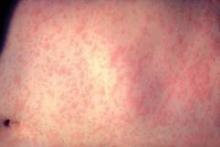Although the United States deserves recognition for sustaining elimination of measles, rubella, and congenital rubella syndrome, importation of the diseases remains a threat, according to research published Dec. 5 in JAMA Pediatrics.
The study, designed to review the evidence for sustained elimination of endemic measles, rubella, and congenital rubella syndrome (CRS), was submitted to the Pan American Health Organization as a way to review the evidence for prevention of the diseases. Measles was declared eliminated from the United States in 2000, and endemic rubella and CRS were eliminated from the United States in 2004.
"Collectively, the very low disease incidences, the high proportions of importation-associated cases, the absence of endemic genotypes, the adequate surveillance, and the high levels of population immunity all indicate that the elimination of endemic measles, rubella, and CRS has been sustained in the United States," reported Dr. Mark J. Papania of the National Center for Immunization and Respiratory Diseases at the Centers for Disease Control and Prevention and his associates. "However, because measles and rubella remain endemic in many parts of the world, importations will continue to occur."
There has been significant global progress in the past 10 years in reducing measles deaths in children, and recent advances in elimination of the disease have been "tremendous but unfinished," Dr. Thomas Frieden, director of the CDC, said at a press conference. He pointed to two small spikes in measles cases in 2011 and 2013, but stressed that less than 2% of the patients in those cases were fully vaccinated. "It is not a failure of the vaccine, it is a failure to vaccinate," he said.
Dr. Samuel L. Katz, chair emeritus of pediatrics at Duke University in Durham, N.C., and coinventor of measles vaccine, highlighted the work of local administrators and health professionals in the field as a major factor in reducing measles deaths around the world. "It’s been 50 years [since the vaccine was invented], and we’re pretty much using the same vaccine in the same way," he said at the press conference, but he mentioned a number of potential improvements to the vaccine currently in development, including microneedles and aerosol sprays.
Dr. Papania and his associates reviewed state health department data submitted to the CDC, as well as data on vaccine exemption and measles and rubella seroprevalence from the National Health and Nutrition Examination Survey. Measles-mumps-rubella (MMR) vaccine coverage data were obtained from the National Immunization Survey, the National Immunization Survey–Teen, and kindergarten immunization surveys conducted by the states (JAMA Pediatr. 2013 Dec. 5 [doi: 10.1001/jamapediatrics.2013.4342]).
There were 911 cases of measles reported between 2001 and 2011, which falls below the elimination criterion of 1 case per 1,000,000 per year. Of those reported measles cases, 801 (88%) were import-associated, the investigators wrote. Sixty-five percent of measles cases were unvaccinated, and 20% had unknown vaccination status.
Rubella and CRS were even rarer, with 77 rubella cases and 4 CRS cases reported between 2004 and 2011. Forty-two rubella cases (54%) were determined to be import-associated, and 88% of patients with the disease were unvaccinated or of unknown vaccination status. The average yearly reported CRS incidence was less than 1 case per 5,000,000 births. Three cases were import-associated, with maternal exposures to rubella occurring outside the United States.
The keys to sustaining elimination of the diseases in the western hemisphere will be sustaining high levels of immunity throughout the U.S. population through vaccination, maintaining strong U.S. surveillance and public health response capacity, and supporting other countries in their efforts, Dr. Papania and his associates concluded.
The investigators also noted that elimination of the diseases in the United States does not necessarily mean extinction, because most U.S. cases of the diseases were traced to other parts of the world or locally transmitted.
The CDC spent approximately $438.9 million from 2001 to 2011 on global measles control activities, the authors wrote, including purchasing more than 200 million doses of the measles vaccine.
No conflict of interest disclosures were reported.



